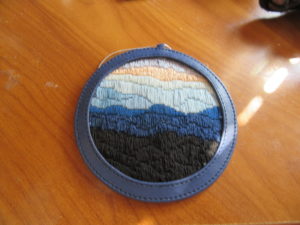
Updated January 4, 2022.
Longstitch was one of the needlepoint techniques that became popular in the ’70s. Made up of long Upright Gobelins, Longstitch has the advantage of being really fast to stitch, easy to do, and forgiving of poorly printed canvases.
It’s mostly gone out of style these days, although I often see kits on eBay. But the kits don’t help the technique one bit. They are made from cheap materials such as acrylic yarn, and often they are not very well designed. As you can see by this artichoke, Longstitch doesn’t need to be relegated to this ghetto of outdated needlepoint.

The artichoke is a hand-painted canvas from Jean Smith. Her bold style, which has large, unshaded areas, is perfect for Longstitch. It’s stitched in JL Walsh silk/wool and #3 perle cotton.
I began by making all the violet edges in Basketweave using pearl cotton. Long vertical or diagonal lines don’t work well in Longstitch, so stitch them first in Tent Stitch. Once these are put in, I began to Longstitch. I used a full strand of silk/wool and followed the painting on the canvas.
This brings up an important point about Longstitch, it is not very sturdy. The stitches run from going over 2 threads to going over 8 or 9. This means they can get caught easily. You would not want to use this technique for items that get much wear.
You also must do Longstitch on a frame. The more the lines of stitches aren’t broken up, as is the case here, the more the canvas buckles. This piece is flat and not distorted, but I have other Longstitch pieces that are a mess. I learned this from bitter experience on the first Longstitch piece I did. Over a decade later, it’s still buckled
When doing Longstitch use flat threads, this means ply and recombine all stranded threads. The beauty comes from the flat stitches, so use a laying tool or redo any twisted stitches.
Not all canvases will work for Longstitch. The perfect candidates have large unshaded blocks of color, little pattern inside areas and few vertical lines.The Blue Ridge round pictured below is another example.

I really love Jean Smith‘s designs for this. The designs are lovely and she conveys so much with color that detailed stitching isn’t necessary. On her site, the 8″ fruits & vegetables and many of the flowers are particularly nice.
Look around you’ll find many other canvases perfect for Longstitch, partly or completely. Whether you use Longstitch for the focal point of a project or combine it with other kinds of stitching, it’s a technique worth knowing.,/font>
About Janet M Perry
Janet Perry is the Internet's leading authority on needlepoint. She designs, teaches and writes, getting raves from her fans for her innovative techniques, extensive knowledge and generous teaching style. A leading writer of stitch guides, she blogs here and lives on an island in the northeast corner of the SF Bay with her family

Kaffe Fassett and his colleagues promoted longstitch as being dead easy to stitch and not needing a frame! Proving that what geniuses find easy, others may find impossible. I bought a good Glorafilia kit from the British Museum about 30 years ago (they no longer offer kits. Spoilsports.) which was based on a Persian plate: round of course, blues and lichen green and a bit of white. Wool. Decent canvas. And instructions that brightly suggested longstitch. I tried. Believe me, I tried. Perhaps the design elements were too small; but it ended up in solid basketweave and looks great instead of messy.
Jill Gordon uses it very well, to be fair. She’s got a waterfall design which is just totally brilliant and wouldn’t work any other way. But I’d be more inclined to do the kind of split satin stitch one uses for crewel shading. That said, your artichoke is fun!
Too true,I think I’m going to look for some pictures and do a gallery od unexpected longstitch.
Keep Stitching,
Janet
Hi Janet! I’m confused, isn’t long stitch just Bargello in disguise? Thanks!
Kathi —
Yes and no. While they both use the same stitch, Straight Gobelin, or Satin, Stitch, Bargello is abstract a geometric patterns repeated while Longstitch is used for pictures of things.
Another difference I’ve seen is that in Longstitch the stitches are irregular in length, the length begin determined by the picture. In Bargello, the stitches are either the same length or in a regular pattern.
Some of this doesn’t hold true for something like free-form Bargello, but it’s mostly this way.
Keep Stitching,
Janet
When using long stitch and you get to end of a row, do you come up and go down in the same hole or into empty holes that have no yarn in order to make them blend? This is a confusing question I am sure. I guess I’m asking if it’s worked like crewel. How do you keep the rows from looking separated or not blended. I doubt this makes sense Sorry.
I’m not sure about what you’re asking. Are you trying to blend thread colors in Longstitch? I don’t think I’ve ever seen that done.
Does anyone with more experience in this technique have some ideas?
Keep stitching,
Janet
Can you do a long stitch kit instead in Continental? If so, does Continental issue more thread?
You could certainly convert Longstitch to Continental. In this case, you would make one Continental for each intersection. I don’t know for sure because I have not done this before, but Continental will take significantly more thread than Longstith.
Keep stitching,
Janet